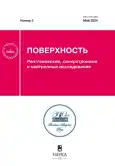Исследование влияния концентрации ферромагнитной примеси на магнитные свойства бинарного сплава палладий–кобальт
- Авторы: Гумарова И.И.1, Гумаров А.И.1, Янилкин И.В.1
-
Учреждения:
- Казанский федеральный университет
- Выпуск: № 5 (2024)
- Страницы: 24-28
- Раздел: Статьи
- URL: https://gynecology.orscience.ru/1028-0960/article/view/664638
- DOI: https://doi.org/10.31857/S1028096024050041
- EDN: https://elibrary.ru/FUMGCX
- ID: 664638
Цитировать
Полный текст
Аннотация
Проведено сравнительное исследование магнитных свойств сплава палладий–кобальт с содержанием примеси до 10 ат. % с помощью расчетов на основе теории функционала плотности и экспериментальных методов. Получено, что сплавы обладают ферромагнитным упорядочением, зависящим от концентрации примеси. При очень малых концентрациях, менее 1 ат. %, величина магнитного момента, приходящегося на один атом примеси, может достигать 25 мкмB.
Ключевые слова
Полный текст
Об авторах
И. И. Гумарова
Казанский федеральный университет
Автор, ответственный за переписку.
Email: iipiyanzina@kpfu.ru
Россия, Казань
А. И. Гумаров
Казанский федеральный университет
Email: iipiyanzina@kpfu.ru
Россия, Казань
И. В. Янилкин
Казанский федеральный университет
Email: iipiyanzina@kpfu.ru
Россия, Казань
Список литературы
- Fallot M. // Ann. Phys. 1938. V. 11. P. 291. https://www.doi.org/10.1051/anphys/193811100291
- Crangle J. // Philos. Mag. 1960. V. 5. P. 335. https://www.doi.org/10.1080/14786436008235850
- Nieuwenhuys G.J. // Adv. Phys. 1975. V. 24. P. 515. https://www.doi.org/10.1080/00018737500101461
- Bagguley D.M.S, Robertson J.A. // J. Phys. F: Met. Phys. 1974.V. 4. P. 2282. https://www.doi.org/10.1088/0305-4608/4/12/023
- Bagguley D.M.S, Crossley W.A., Liesegang J. // Proc. Phys. Soc. 1967. V. 90. P. 1047. https://www.doi.org/10.1088/0370-1328/90/4/316
- Рязанов В.В. // УФН. 1999. Т. 169. С. 920. https://www.doi.org/10.3367/UFNr.0169.199908g.0920
- Larkin T.I., Bol’ginov V.V., Stolyarov V.S, Ryazanov V.V., Vernik I.V., Tolpygo S.K., Mukhanov OA. // Appl. Phys. Lett. 2012. V. 100. P. 222601. https://www.doi.org/10.1063/1.4723576
- Soloviev I.I., Klenov N.V., Bakurskiy S.V., Kupriyanov M.Y., Gudkov A.L., Sidorenko A.S. // Beilstein J. Nanotechnol. 2017. V. 8. P. 2689. https://www.doi.org/10.3762/bjnano.8.269
- Esmaeili A., Yanilkin I.V., Gumarov A.I., Vakhitov I.R., Yusupov R.V., Tatarsky D.A., Tagirov L.R. // Sci. China Mater. 2021. V. 64. P. 1246. https://www.doi.org/10.1007/s40843-020-1479-0
- Mohammed W.M., Yanilkin I.V., Gumarov A.I., Kiiamov A.G., Yusupov R.V., Tagirov L.R. // Beilstein J. Nanotechnol. 2020. V.11. P. 807. https://www.doi.org/10.3762/bjnano.11.65
- Yanilkin I.V., Mohammed W.M., Gumarov A.I., Kiia-mov A.G., Yusupov R.V., Tagirov L.R. // Nanomaterials 2021. V. 11. P. 64. https://www.doi.org/10.3390/nano11010064
- Gumarov A.I., Yanilkin I.V., Yusupov R.V., Kiiamov A.G., Tagirov L.R., Khaibullin R.I. // Mater. Lett. 2021. V. 305. P. 130783. https://www.doi.org/10.1016/j.matlet.2021.130783
- Gumarov A.I., Yanilkin I.V., Rodionov A.A., Gabbasov B.F., Yusupov R.V., Aliyev M.N., Tagirov L.R. // Appl. Magn. Reson. 2022. V. 53. P. 875. https://www.doi.org/10.1007/s00723-022-01464-0
- Hohenberg P., Kohn W. // Phys. Rev. 1964. V. 136. P. B864. https://www.doi.org/10.1103/PhysRev.136.B864
- Kohn W., Sham L.J. // Phys. Rev. 1965. V. 140. P. A1133. https://www.doi.org/10.1103/PhysRev.140.A1133
- Perdew J.P., Burke K., Ernzerhof M. // Phys. Rev. Lett. 1996. V. 77. P. 3865. https://www.doi.org/10.1103/PhysRevLett.77.3865
- Blöchl P.E. // Phys. Rev. B. 1994. V. 50. P. 17953. https://www.doi.org/10.1103/PhysRevB.50.17953
- Kresse G., Furthmüller J. // Comp. Mater. Sci. 1996. V. 6. P. 15. https://www.doi.org/10.1016/0927-0256(96)00008-0
- Kresse G., Furthmüller J. // Phys. Rev. B. 1996. V. 54 P. 11169. https://www.doi.org/10.1103/PhysRevB.54.11169
- Kresse G., Joubert D. // Phys. Rev. B. 1999. V. 59. P. 1758. https://www.doi.org/10.1103/PhysRevB.59.1758
- MedeA version 3.7; MedeA is a registered trademark of Materials Design, Inc., San Diego, USA.
- Dudarev S.L., Botton G.A., Savrasov S.Y., Humphreys C.J., Sutton A.P. // Phys. Rev. B. 1998. V. 57. № 3. P. 1505. https://www.doi.org/10.1103/PhysRevB.57.1505
- Calderon C.E., Plata J.J., Toher C. et al. // Comp. Mater. Sci. 2015. V. 108. P. 233. https://www.doi.org/10.1016/j.commatsci.2015.07.019
- Piyanzina I., Gumarov A., Khaibullin R., Tagirov L. // Crystals. 2021. V. 11. P. 1257. https://www.doi.org/10.3390/cryst11101257
- Himpsel F.J., Ortega J.E., Mankey G.J., Willis R.F. // Magn. Nanostructures, Adv. Phys. 1998. V. 47. P. 511. https://www.doi.org/10.1080/000187398243519
Дополнительные файлы












